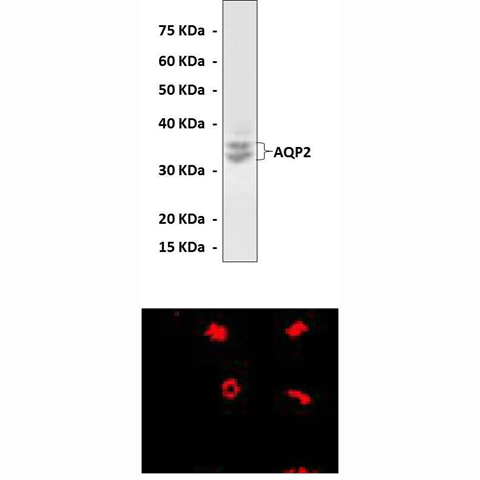Anti-AQP2: Polyclonal Aquaporin 2 Antibody |
 |
BACKGROUND Aquaporins (AQPs) are membrane water channels that play critical roles in controlling the water contents of cells. These channels are widely distributed in all kingdoms of life, including bacteria, plants, and mammals. More than ten different aquaporins have been found in human body, and several diseases, such as congenital cataracts and nephrogenic diabetes insipidus, are connected to the impaired function of these channels. They form tetramers in the cell membrane, and facilitate the transport of water and, in some cases, other small solutes across the membrane. However, the water pores are completely impermeable to charged species, such as protons, a remarkable property that is critical for the conservation of membrane's electrochemical potential, but paradoxical at the same time, since protons can usually be transfered readily through water molecules. Water molecules passing the channel are forced, by the protein's electrostatic forces, to flip at the center of the channel, thereby breaking the alternative donor-acceptor arrangement that is necessary for proton translocation.1
AQP2 is expressed in the principal cells of the collecting ducts in the kidney and plays a critical role in the urine concentration. A unique feature of AQP2 is that it is stored in the intracellular compartment, and upon stimulation of an antidiuretic hormone (ADH, vasopressin), AQP2 translocates to the apical plasma membrane, where it serves in the uptake of water from the lumen of the collecting duct. It has been shown that AQP2 vesicles constitute a distinct intracellular compartment mostly in the apical cytoplasm and partially overlapping with early endosomes in collecting duct cells in the rat kidney. The AQP2 compartment is distinct from lysosomes, trans-Golgi network (TGN), Golgi apparatus, and endoplasmic reticulum. Numerous studies have focused on AQP2 trafficking from the intracellular compartment to the apical plasma membrane in response to ADH, and a signaling pathway via phosphorylation by protein kinase A and protein kinase G has been proposed. Moreover, its retrieval may use the apical endosomal system and the phosphatidylinositol 3-kinase-dependent pathway.2 In addition, the mutation of AQP2 leads to nephrogenic diabetes insipidus, the inability to concentrate urine.3
AQP2 is expressed in the principal cells of the collecting ducts in the kidney and plays a critical role in the urine concentration. A unique feature of AQP2 is that it is stored in the intracellular compartment, and upon stimulation of an antidiuretic hormone (ADH, vasopressin), AQP2 translocates to the apical plasma membrane, where it serves in the uptake of water from the lumen of the collecting duct. It has been shown that AQP2 vesicles constitute a distinct intracellular compartment mostly in the apical cytoplasm and partially overlapping with early endosomes in collecting duct cells in the rat kidney. The AQP2 compartment is distinct from lysosomes, trans-Golgi network (TGN), Golgi apparatus, and endoplasmic reticulum. Numerous studies have focused on AQP2 trafficking from the intracellular compartment to the apical plasma membrane in response to ADH, and a signaling pathway via phosphorylation by protein kinase A and protein kinase G has been proposed. Moreover, its retrieval may use the apical endosomal system and the phosphatidylinositol 3-kinase-dependent pathway.2 In addition, the mutation of AQP2 leads to nephrogenic diabetes insipidus, the inability to concentrate urine.3
REFERENCES
1. Jensen, M. Ø. Et al: Structure 9:1083-1093, 2001
2. Tajika, Y. et al: Endocrinol. 145: 4375-83, 2004
3. Tamarappoo, B.K. & Verkman, A.S.: J. Clin. Investig. 101:2257-67, 1998
2. Tajika, Y. et al: Endocrinol. 145: 4375-83, 2004
3. Tamarappoo, B.K. & Verkman, A.S.: J. Clin. Investig. 101:2257-67, 1998
Products are for research use only. They are not intended for human, animal, or diagnostic applications.
Параметры
Cat.No.: | CA0649 |
Antigen: | C- terminal sequence of human Aquaporin 2 |
Isotype: | Affinity-Purified Rabbit Polyclonal IgG |
Species & predicted species cross- reactivity ( ): | Human, Rabbit, Rat, Mouse |
Applications & Suggested starting dilutions:* | WB 1:500 to 1:1000 IP n/d IHC (Paraffin) 1:50 to 1:200 ICC n/d FACS n/d |
Predicted Molecular Weight of protein: | 32/34 kDa |
Specificity/Sensitivity: | No cross-reactivity with other members of the family |
Storage: | Store at 4° C for frequent use; at -20° C for at least one year. |
*Optimal working dilutions must be determined by end user.
Документы
Информация представлена исключительно в ознакомительных целях и ни при каких условиях не является публичной офертой








